Austro-Hungarian large-caliber guns of the First World War
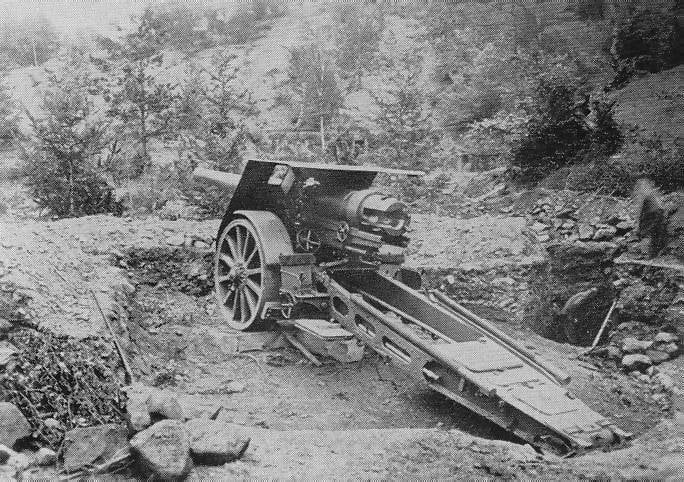
said it's thunder.
Gospel of John 12:29
Heavy artillery of the First World War. Not so long ago I read that some American military man, having seen pictures of the battles in the Northern Military District, said that he was surprised at how much it all reminded him of the pictures of the battles of the First World War, although more than 100 years had passed. And there is really nothing to be surprised about here. People are slaves of circumstances, and since everything has turned out this way, it means that the circumstances that affect them are just that.
And what do we see? And we still see the exceptionally large role of artillery, and large calibers of 155, 203 and 240 mm. That is story made another round and almost returned to where it started. But, of course, there is a difference between the artillery of 1914 and 2022, and a considerable one.
But what was it like, the artillery of the warring countries?
We will tell about this, and we will start with the letter "A", which means - with the artillery of the Austro-Hungarian monarchy.
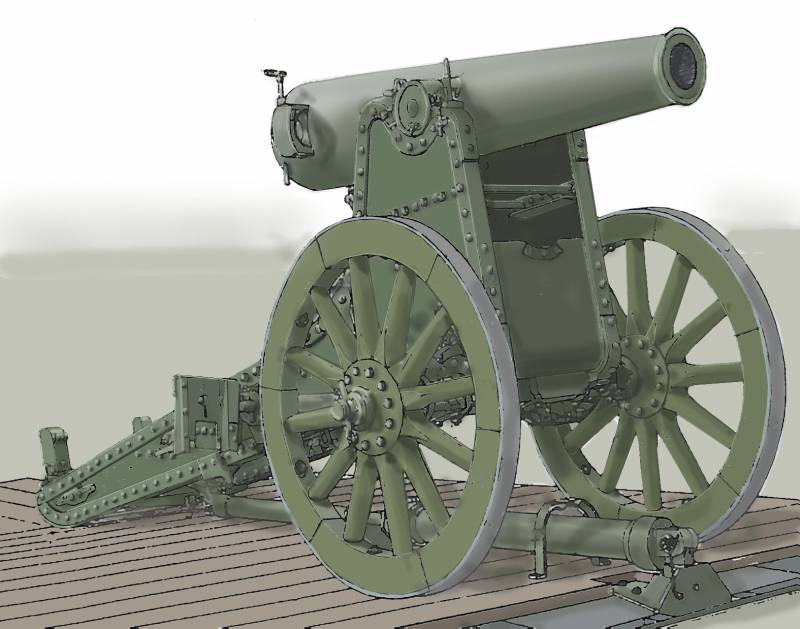
120 mm gun M.80. Well, straight from the book about Captain Daredevil. By the way, a very similar 1877-mm caliber gun of the 152 model was in the Museum of the Soviet Army in Moscow. Rice. A. Sheps
You will have to start with the fact that, although the armies of Europe on the eve of the First World War were modernizing the artillery park, the Austro-Hungarian army, like all other European armies, entered the war with a considerable part of the artillery represented by obsolete models.
These were 120 mm M.80 caliber guns, the same 150 mm gun - M.80, and the 180 mm short gun ... also M.80, and all three were almost identical, except for the caliber. All carriages, for example, were the same. In the Austro-Hungarian army, they had the designation Mobile Festungsartillerie - "mobile fortress artillery".
All three types were hard-mounted guns, without any modern recoil compensation mechanism. However, there was a cylindrical hydraulic mechanism with a cylinder and rod, which was often placed under the gun and attached to a properly prepared platform, which was used in deployment.
When the gun fired, it rolled back and at the same time moved up on special triangular wheel stands. While the piston attached to the gun carriage was pulled out of the cylinder attached to the platform slowed down the recoil, eventually returning the gun to its original position. The main difference between these guns were, as already mentioned, gun tubes, giving them the appropriate designation. They are briefly presented below.
Gun types: 12 cm M.80, 15 cm M.80, 18 cm M.80.
Barrel length, in calibers: 26,6; 24,2; 12,3.
Barrel length, in meters: 3,2; 3,6; 2,22.
Barrel weight: 1 kg, 700 kg, 3 kg.
Projectile weight: 16,7–19,8 kg; 31,5 kg; 62,5 kg.
Maximum firing range: 8 m; 000 m; 11 200 m.
It seems that the 15cm and 18cm M.80 (the Austro-Hungarians adopted the German centimeter caliber designation) were used almost exclusively in fortresses like Krakow and, of course, Przemysl. However, the 12-cm gun, which had a relatively long range and low weight, could be used and was used as field artillery. At the beginning of the war, the army was armed with 20 batteries, 4 guns of 12-cm M.80 each.
During the first two years of the war, it was originally the main long-range gun of the Austro-Hungarian army. However, the need to increase artillery support in the range of medium-caliber guns forced the Austro-Hungarian army to withdraw several 80 cm and 12 cm caliber M.15 fortress batteries and use them in the field.
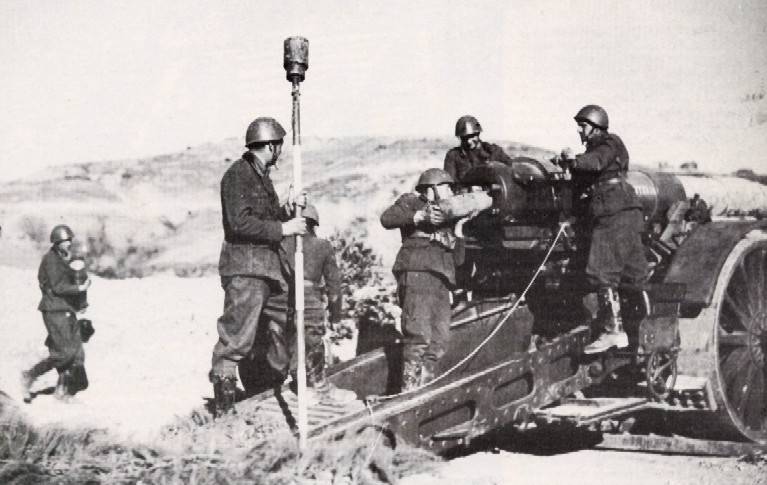
Combat work M.15/16
As already noted, all three guns had the same carriage (that's when people were already striving for unification), which facilitated their maintenance and repair.
Many types of artillery were produced by Skoda. Long before the start of the war, it became clear that the army needed a new 150-mm gun. And it was at this enterprise that they began to develop it and called it “15cm Autokanone M.15 / 16” - that is, a tool that can be transported on mechanical traction. They needed to replace the 1888 model gun. But only in 1915, the first prototype of this gun was tested, and it entered service in 1916.
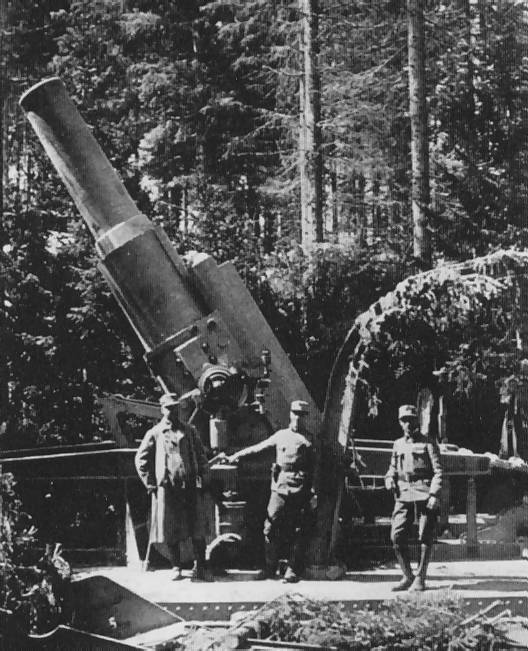
38 cm howitzer M.16
The gun turned out to be large, rather clumsy and heavy, and for transportation it had to be broken into two parts (barrel and gun carriage), although it was originally designed specifically as an “Autocanon”, that is, as a gun that was supposed to be towed by motorized tractors without disassembly.
The design of the gun was standard, with a hydraulic recoil absorption mechanism. With this tool, Austria-Hungary fought until its very end and collapse, and then it was used by the armies of many states.
And this is not surprising, since its purely artillery characteristics were not so bad. A projectile with a mass of 56 kg had an initial speed of 700 m / s, and flew at a distance of more than 16 km.
After the release of the first 28 copies, the mechanisms of the gun were finalized, which made it possible to increase the elevation angle of the barrel from + 30 ° to + 45 °, which, with a new type of projectile with a more streamlined outline, gave a maximum firing range of about 21 km. This slightly modified gun was designated M.15/16.
The rate of fire was low: one round per minute, and the turn on the carriage was limited: 6 ° in each direction. The gun weighed 11,9 tons in the firing position and 16,4 tons in the stowed position. It is not surprising that for its maintenance a calculation of 13 people was required. Moreover, its real caliber was still 152 mm, not 150, and the barrel length reached 5,1 m. The gun had a removable shield to protect its calculation from fragments.
Although cumbersome, it was a powerful gun, and after the First World War it was used by the armies of Austria (though only two guns), Czechoslovakia and Italy, who received several of these guns as trophies and reparations and used them under the designation Cannone da 152/37 - where the number "37" indicates the approximate length of the barrel in calibers.
During the 20s, Italian guns were carefully repaired by Vickers-Terni and received new cartridge cases, chambers and wheels. By June 1940, the Italians still had 29 of these guns in service, and they had to take part in the fighting in Albania, Greece and North Africa. By the end of 1940, they had 21 operational guns left, and all but four of them were in Italy, some of which were used as coastal defense guns.
The German army also began to use these guns! In 1939, those guns that were in Czech service were put into reserve, but they were recognized as serviceable enough to interest the Germans, who used them in the defense of the Atlantic Wall under the designation 15,2cm K 15/16 (t). Later in 1943, some of these guns, still in Italian service, were transferred to the Germans under the designation 15,2cm K 410(i). However, it is doubtful that the German army ever used them in combat.
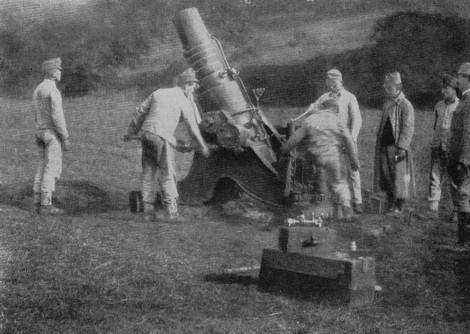
240mm mortar M.98
A cannon is a cannon, it cannot reach the enemy on the reverse slopes of ravines and in trenches. This was clear long before the war and led to the fact that in 1898 the Skoda team developed a 240-mm mortar for the army. The M.98 weighed about 9,3 tons in firing position. It was transported only unassembled, for which it was disassembled into four sets of parts, each of which was pulled by horses or cars.
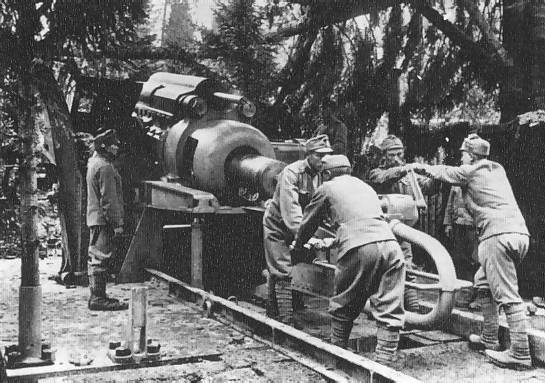
And this is how the 38 cm M.16 howitzer was loaded
Despite this, the deployment of the gun was "comparatively fast", according to the Austrian military. The barrel length was 2 mm, elevation angles were from +180° to +44°. Horizontal aiming - 65 °. The mortar could fire a 16-kilogram high-explosive projectile at about 133 meters. The initial speed of the projectile was 6 m / s. For service, a calculation of 500 people was required. To protect against enemy fire, it could be equipped with a shield.
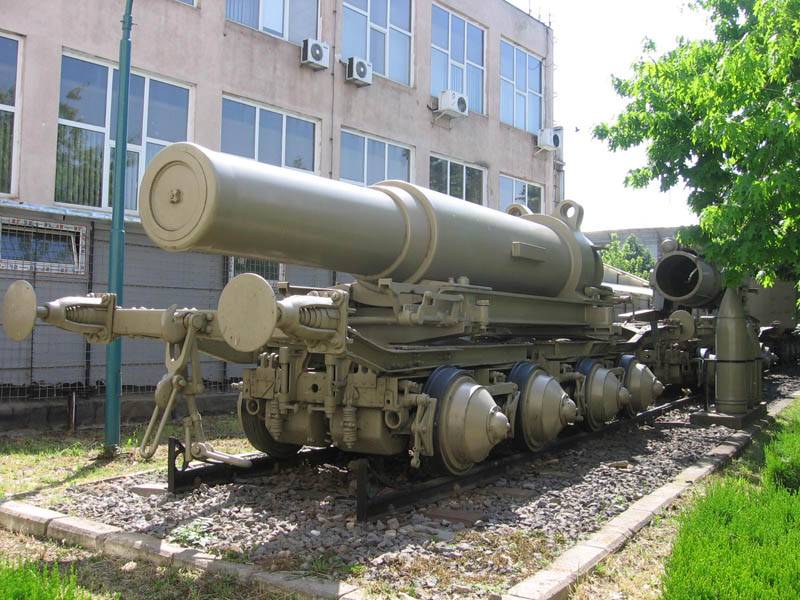
Well, in this form it can be seen in the National Army Museum in Bucharest. This is the barrel on the conveyor
At the beginning of the First World War in August 1914, the Austro-Hungarian army was armed with 12 24-cm mortar batteries (each battery consisted of 4 guns), a total of about 96 guns (as in the case of the Austro-Hungarian artillery in general, there were problems with the supply of ammunition: there were only about 400 shells per gun). In January 1917, only about 30 M.98s were in service, and a year later it was reduced even more, so that only 2 batteries of 8 guns were active at the front.
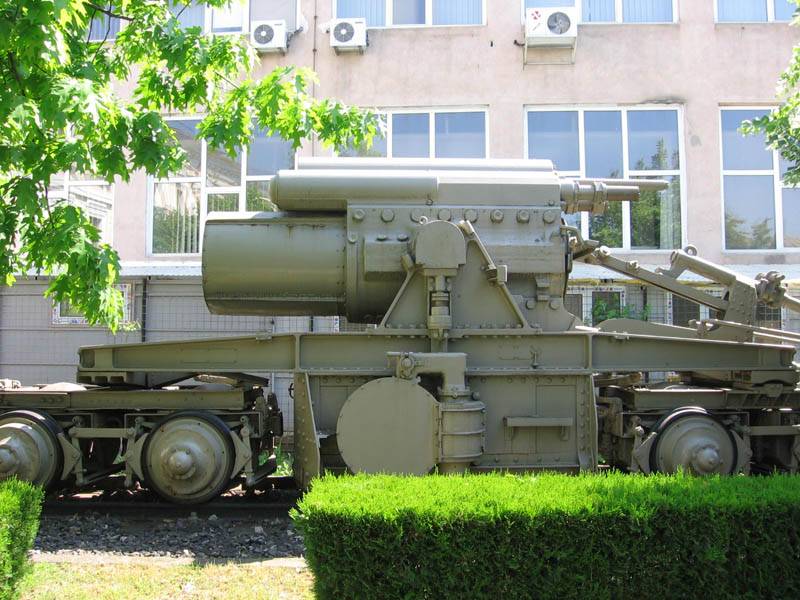
And this is the carriage on which the barrel was fixed
In the early stages of World War I, the Austro-Hungarian 30,5 cm M.11 mortar was probably the most feared weapons, which could only be in service with any army, and it was used with impressive effect both on the Western Front and in the East, both in the Balkans and against Italy.
Design of the M.11 began in 1905, when the Austro-Hungarian General Staff ordered a gun heavy enough to destroy new Italian fortifications erected on the border between the two countries. The order went to the Škoda company in Pilsen, which had already made a name for itself by producing many excellent guns.
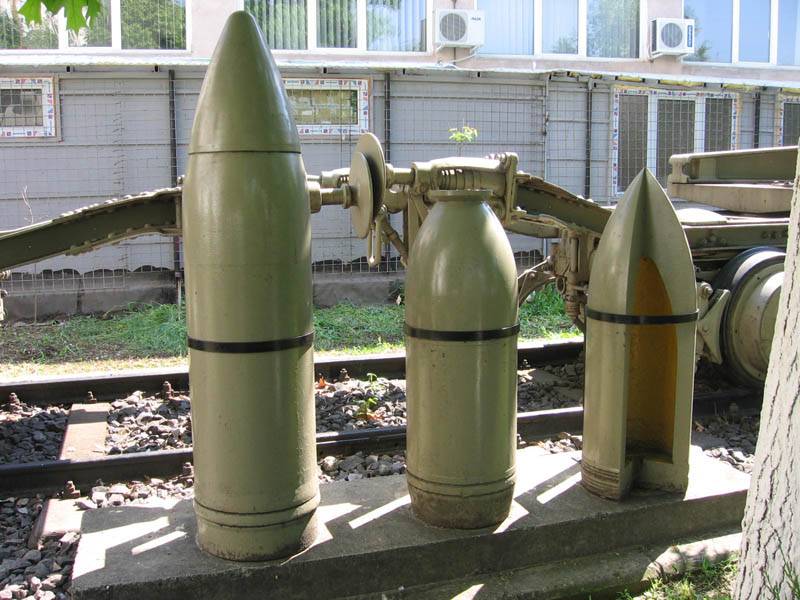
And these are the shells that flew out of this barrel!
Work on the mortar was completed in July 1908, and the first prototype was made the following year. In the summer of 1911, it was tested and showed excellent results, and then the mortar was adopted under the designation "30,5 cm Mörser M.11". The first order was received in December 1911 for the construction of 24 M.11s.
Considering the year, it was a very modern gun. The breech had a horizontal wedge gate, with several fuses from an accidental shot. Above the barrel were two cylinders: they housed the recoil brake. Three more cylinders were located under the barrel: they housed the knurler, i.e., the mechanism responsible for the forced return of the gun barrel to its original position after the shot.
The barrel and cradle were attached to the lower carriage, on which were the guidance mechanisms. The carriage rested on a base plate. The gun itself, of course, was very heavy: 20 kg, in order to move the M.830, the installation had to be dismantled, which, however, was done quite quickly, using only jacks and lifts.
As a result, the gun was disassembled into three large parts: the barrel, carriage and support box, which were mounted on special wheeled carriages. All of them were attached to a large 15-ton Skoda-Daimler M.12 tractor. The train was not fast, but it turned out to be surprisingly mobile. If the road was of acceptable quality, then the mortar could be transported in this way even in the Alps!
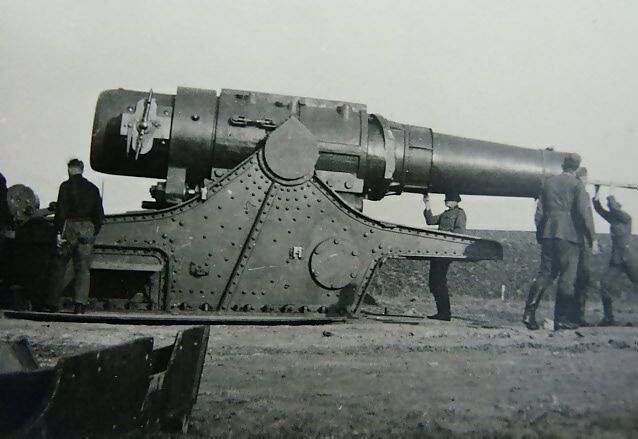
Carriage for transporting the barrel of a 420-mm howitzer
It soon became clear that modern forts could withstand any amount of shelling from conventional field artillery up to 210 mm in caliber. This was proved by the experience of Verdun, where such forts as Duamount or Vaud were not suppressed, although they were literally bombarded with shells. Only in the end they still had to be taken by storm.
On the contrary, almost nothing could resist a direct hit from a M.11 projectile. An M.11 grenade could penetrate two meters of concrete and explode inside the fort.
An unforeseen consequence of such a hit was the smoke from the explosion, which filled the casemates and corridors, forcing the defenders to leave the attacked fort. Simply put: there was no real protection against the projectiles of this mortar, unless the object of destruction was at a depth of about 3 meters in solid rock, or perhaps was covered with reinforced concrete of the same thickness. An explosive grenade fired from the M.11 created a crater about 5–8 meters in diameter: shrapnel from the explosion could penetrate solid structures at a distance of 100 meters and kill unprotected people at a distance of 400 meters. Only one M.11 grenade fuse could do as much damage as a full 15 cm grenade! All in all, it was a truly terrible weapon.
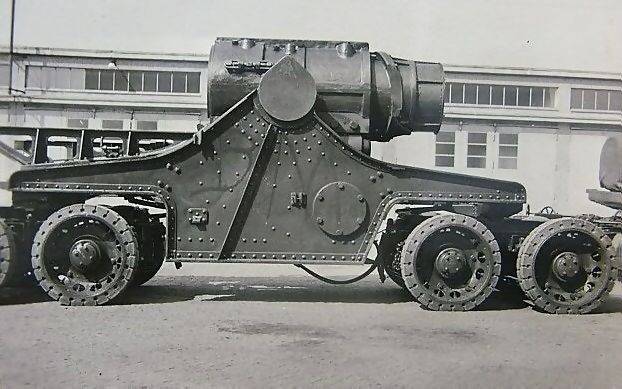
] 420-mm howitzer carriage on a chassis for transportation
During 1915, the Austro-Hungarian army received 20 M.11 batteries. Although the standard set of the M.11 battery consisted of 2 guns, each such mortar could be used one by one. This is due to a characteristic feature of the Austro-Hungarian army: unlike the Germans, it did not have a centralized artillery command. Even very heavy guns were placed under the control of divisional commanders, which gave each division close support, but at the same time reduced the number of guns that could be concentrated at one point. This, of course, was a consequence of the fact that the German army was more attack-oriented, while the Austrians and Hungarians quickly lost confidence in themselves and became more and more defensive-oriented.
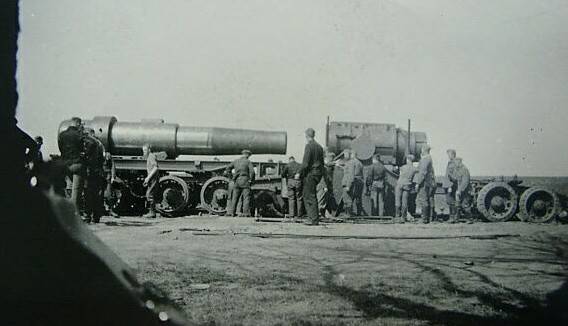
Assembling the gun
Appetite comes with eating. Here in the Austro-Hungarian army they decided that 305 mm is, of course, good, but 380 mm is even better, and again they ordered such a gun from Skoda. Development began in April 1915, and simultaneously with the 42 cm howitzer.
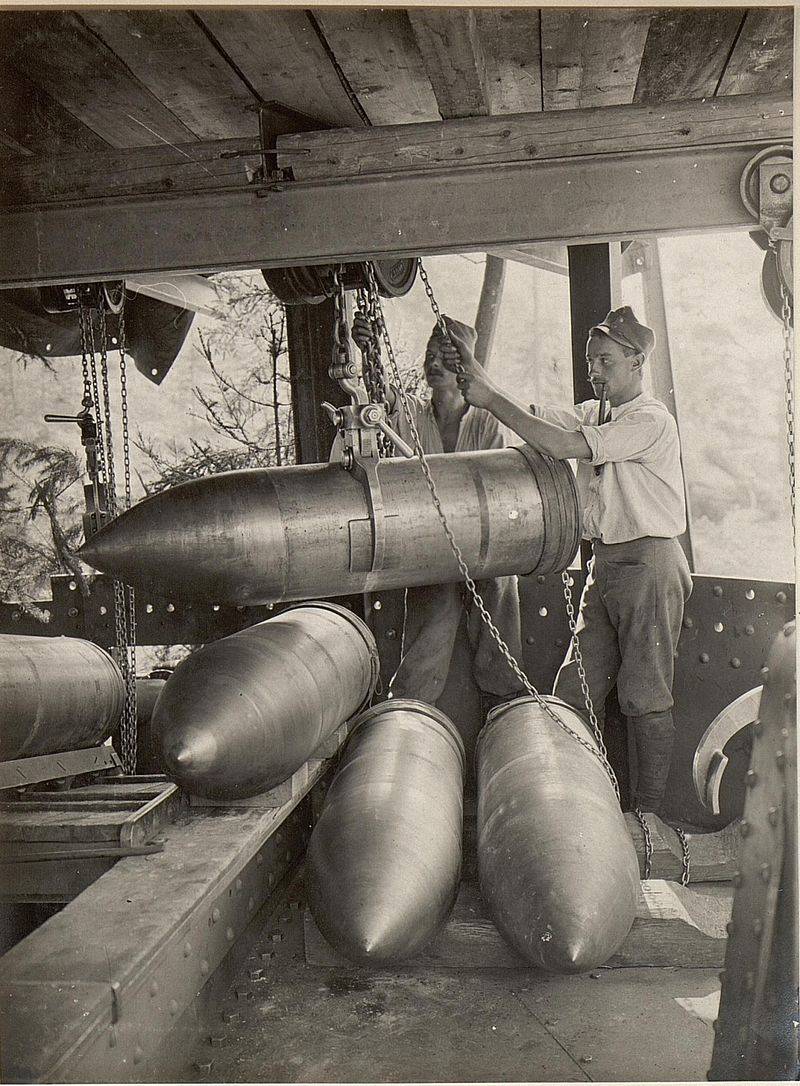
High-explosive grenades for 420 mm howitzer
The first two guns of the 38-centimeter caliber M.16 even had their own names: "Gudrun" and "Barbara". They were involved on the Italian front to support the next offensive on the Isonzo River. The experience was considered successful, and the Austro-Hungarian high command ordered an additional 14 M.16 howitzers. They were used on all fronts with impressive effect, so that at the end of the war the Austro-Hungarian army already had ten of these monsters in service.
M.16 weighed about 81,7 tons in combat position, and it took about 6-8 hours to transfer it from traveling to combat position. She could fire a 740 kg projectile out to about 15 meters. The maximum rate of fire was 000 rounds per hour, or one shot every 12 minutes.
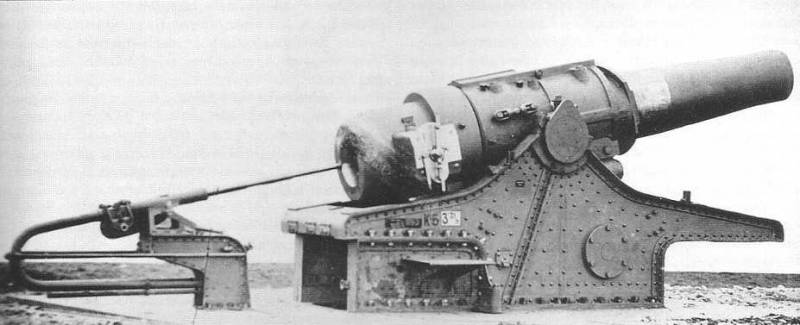
420 mm gun barrel
As for the Austro-Hungarian 42 cm howitzer, it was probably the most powerful artillery piece used in the First World War.
Interestingly, at first it was not conceived as a land weapon, but was intended to be used against naval targets, that is, to protect naval bases in the Aegean Sea. However, very soon the Austro-Hungarian high command found that the threat from the sea was less than the need for heavy artillery on the land fronts. Therefore, Skoda was asked to make these howitzers mobile, or at least transportable. Which is what was done.
As a result, the army received the 42 cm Haubitze M.14.
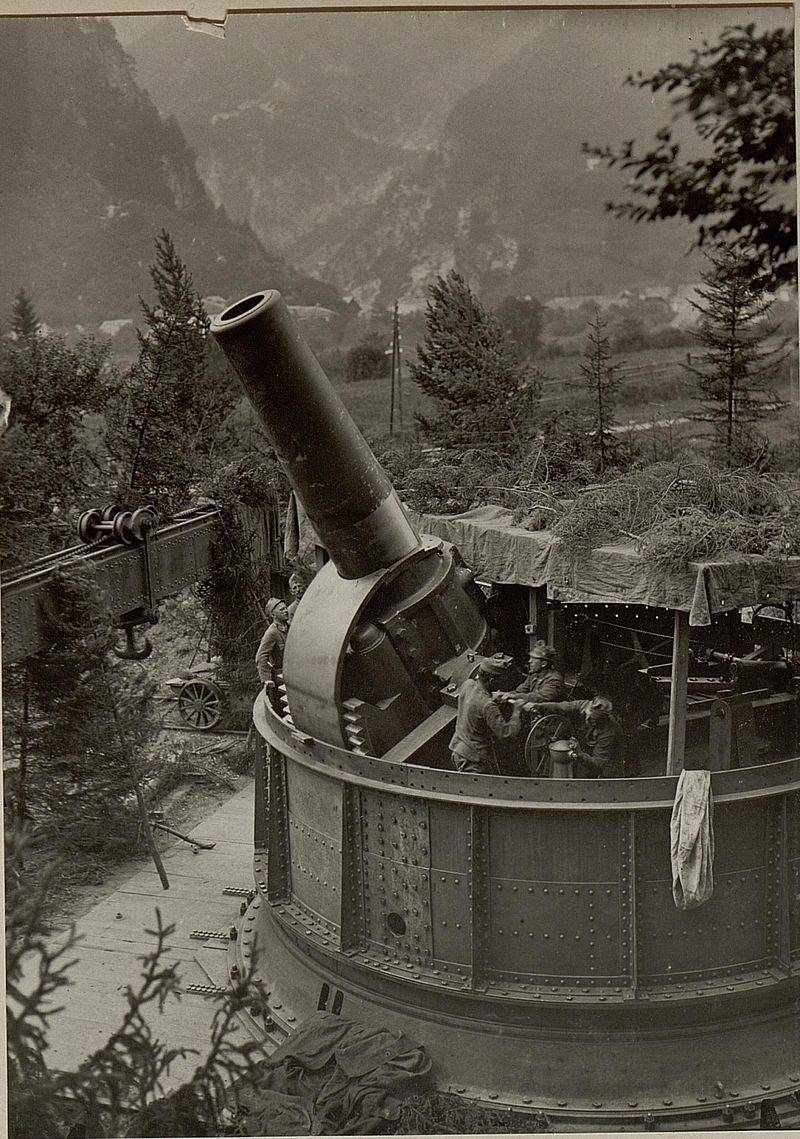
42-cm Haubitze M.14 - such installation in the First World War could fire 360 °
The new gun was already used in the summer of 1915 on the Serbian, Russian and Italian fronts. But since it turned out to be very heavy, work on it was continued.
As a result, a tool was created, transported in six packs, which were transported by heavy tractors. The model received the designation M.16, and a year later the 42-cm Autohaubitze M.17, that is, the “vehicle-transportable howitzer,” appeared.
She did not manage to take part in the hostilities in the First World War, but she was used first by the Czech army, and then after the occupation of Czechoslovakia, the German army took the M.17 and fired at the Maginot Line from it, and later in 1942 used it to bombard Sevastopol, for which this heavy howitzer was just perfect.

And this is what it looked like during the Second World War
Thus, at the end of the First World War, the Austro-Hungarian army was armed with 8 42-cm howitzers M.14, M.16 and M.17, which were used on all fronts with considerable success. Considering their weight, they were surprisingly mobile. But moving these monsters was not easy: the calculation of one gun consisted of 210 people, 8 officers, 5 horses, 4 wagons and 32 (!) Trucks with trailers.
But, as they say, it was just something. With a caliber of 420 mm, the weight of a high-explosive projectile for this howitzer was about one ton. Its initial speed was 415 m/s. Firing range: 12 m. On her installation, she could fire at 700 °, at angles of elevation of the barrel from + 360 ° to + 40 °. Although the weight of the installation at the same time was 70 kg, it was assembled in 112 hours and disassembled in 735!
Information